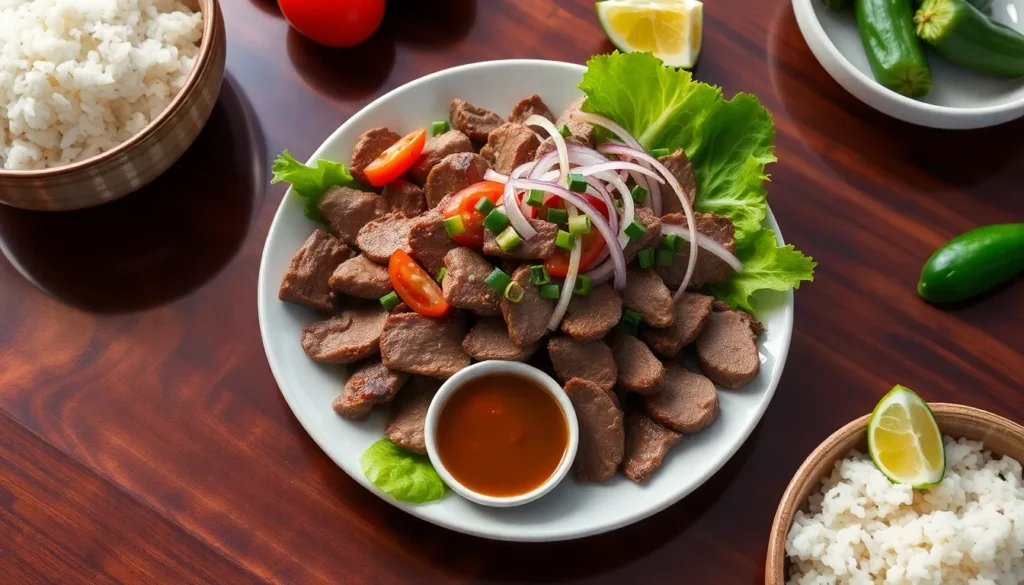We’re about to take you on a culinary journey to Cambodia with one of the country’s most beloved dishes – Beef Lok Lak. This iconic Khmer stir-fry combines tender marinated beef with a perfect balance of sweet and savory flavors that’ll make your taste buds dance with excitement.
What makes Lok Lak truly special isn’t just its incredible taste but also its fascinating history. This dish represents the beautiful fusion of Cambodian and French colonial influences, creating something uniquely delicious that’s become a staple in restaurants across Southeast Asia and beyond.
We’ve perfected this recipe to bring authentic Cambodian flavors right to your kitchen. The secret lies in the marinade and that signature tangy dipping sauce that transforms simple ingredients into an extraordinary meal. Ready to discover why Beef Lok Lak has captured hearts worldwide?
Ingredients
Now we’ll gather all the essential components needed to create this authentic Cambodian masterpiece. Each ingredient plays a crucial role in building the complex layers of flavor that make Beef Lok Lak so memorable.
For the Beef
- 1 pound beef sirloin or tenderloin, cut into 1-inch cubes
- 2 tablespoons vegetable oil for searing
For the Marinade
- 3 tablespoons soy sauce
- 2 tablespoons oyster sauce
- 1 tablespoon brown sugar
- 2 cloves garlic, minced
- 1 teaspoon freshly ground black pepper
- 1 tablespoon cornstarch
- 2 teaspoons sesame oil
For the Dipping Sauce
- 3 tablespoons fresh lime juice
- 2 tablespoons fish sauce
- 1 tablespoon sugar
- 2 Thai chilies, finely chopped
- 2 cloves garlic, minced
- 1 tablespoon water
For Serving
- 4 cups cooked jasmine rice
- 2 large tomatoes, sliced
- 1 cucumber, sliced
- 4 cups mixed lettuce leaves
- Fresh cilantro sprigs
- Lime wedges for garnish
Equipment Needed
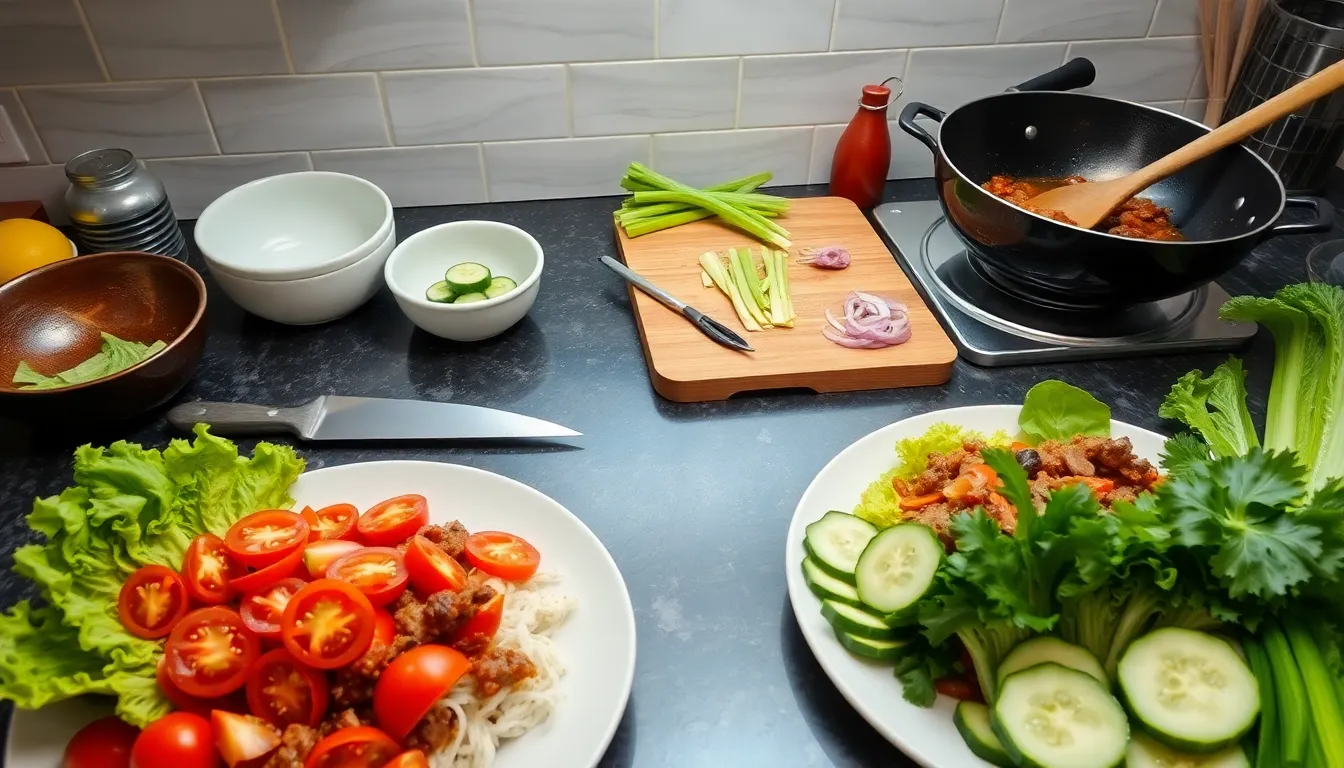
Preparing authentic Beef Lok Lak requires exact kitchen tools that ensure proper cooking technique and presentation. We need a sharp knife and cutting board as our foundation for slicing the beef into perfect cubes and preparing fresh vegetables for serving.
A mixing bowl serves as our workspace for marinating the beef and combining the tangy dipping sauce ingredients. The marinating process demands adequate space to coat each piece thoroughly with our flavorful sauce blend.
Our cooking vessel plays a crucial role in achieving the signature “shaking” technique that gives this dish its nickname. We recommend using a wok or large skillet capable of withstanding high heat for quick stir frying. The wide surface area allows us to toss and shake the beef cubes effectively while maintaining even heat distribution.
A sturdy spoon or spatula becomes essential for the characteristic tossing motion during cooking. This tool helps us achieve the proper searing on all sides of the beef while preventing sticking to the cooking surface.
Large serving plates complete our equipment list since traditional presentation requires ample space for arranging fresh lettuce beds alongside the cooked beef. These plates accommodate the colorful array of sliced tomatoes and cucumbers that accompany our finished dish.
| Equipment | Primary Use | Importance Level |
|---|---|---|
| Sharp knife & cutting board | Beef cubing and vegetable prep | Essential |
| Mixing bowls | Marinating and sauce preparation | Essential |
| Wok or large skillet | High-heat stir frying | Critical |
| Spoon or spatula | Tossing and shaking beef | Essential |
| Large serving plates | Traditional presentation | Important |
Each piece of equipment contributes to the authentic preparation method that makes Beef Lok Lak distinctive among Cambodian dishes.
Prep Instructions

Proper preparation forms the foundation of exceptional Beef Lok Lak. We’ll guide you through each essential step to ensure your beef achieves the perfect texture and flavor balance.
Preparing the Beef
We start by selecting the right cut of beef for optimal results. Sirloin, ribeye, or flat iron work exceptionally well for this dish. Cut the beef into small cubes or thin slices to ensure even cooking and maximum flavor absorption.
For tougher cuts, we recommend a simple tenderizing technique. Mix 1 teaspoon of baking soda with 1/2 cup of water in a bowl. Submerge the beef pieces and let them sit for 10-15 minutes. Rinse the meat thoroughly under cold water to prevent over-tenderization, which can affect the final texture.
Pat the beef dry with paper towels before proceeding to the marinating step. This ensures the marinade adheres properly to the meat surface.
Making the Marinade
Our marinade combines traditional Cambodian flavors that penetrate the beef for maximum taste. Mix soy sauce, oyster sauce, fish sauce, sugar, salt, black pepper, and minced garlic in a large mixing bowl. Whisk these ingredients together until the sugar completely dissolves.
Add the prepared beef to the marinade mixture, ensuring each piece gets completely coated. We recommend marinating for at least 20 minutes for basic flavor development. For deeper flavor penetration, marinate the beef for up to 24 hours in the refrigerator.
Toss the beef occasionally during the marinating process to redistribute the flavors evenly throughout all pieces.
Preparing the Dipping Sauce
The signature dipping sauce elevates Beef Lok Lak from good to extraordinary. Combine fresh lime juice, black pepper, and salt in a small bowl. This simple yet powerful combination provides the tangy contrast that balances the rich marinated beef.
Adjust the sauce to your taste preferences by adding more lime juice for extra tartness or additional salt for enhanced flavor depth. We suggest preparing this sauce just before serving to maintain the bright lime flavor.
Store any leftover dipping sauce in the refrigerator for up to three days, though it tastes best when freshly made.
Cooking Instructions
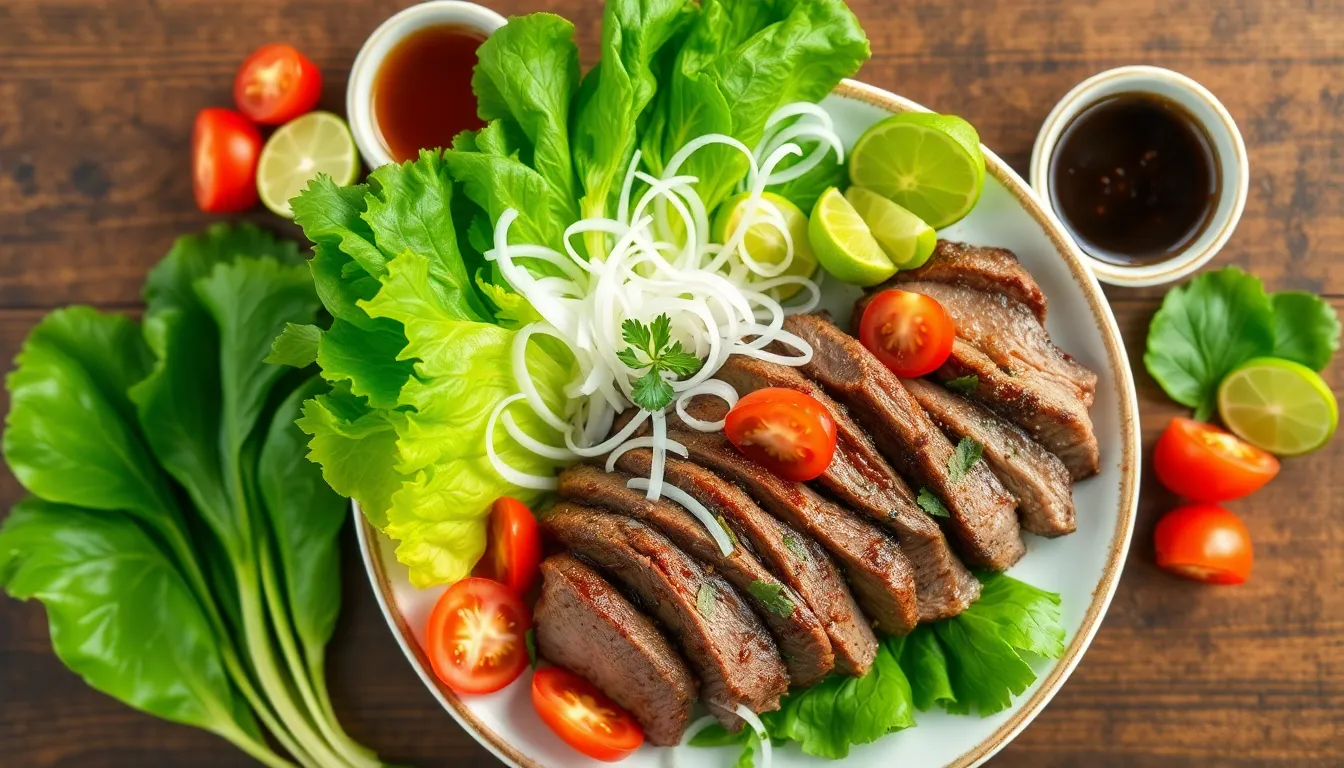
Now that we have our ingredients prepped and equipment ready, let’s transform these components into an authentic Beef Lok Lak. The cooking process involves three key stages that work together to create the perfect balance of flavors and textures.
Marinating the Beef
We begin by placing our cubed beef into a large mixing bowl. Pour the prepared marinade over the beef pieces and use clean hands to ensure every cube gets evenly coated. The dark soy sauce will begin to work its magic immediately, giving the beef a beautiful caramelized color while the oyster sauce adds depth and umami richness.
Allow the beef to marinate for at least 20 minutes at room temperature for basic flavor penetration. For deeper flavor absorption, we recommend marinating for up to 1 hour, though the beef should not sit longer than this to maintain optimal texture. During the marinating process, the palm sugar dissolves completely while the fish sauce and freshly ground black pepper penetrate the meat fibers.
Toss the beef cubes every 10 minutes during marination to ensure even distribution of flavors. The garlic will release its aromatic oils, creating a fragrant base that defines authentic Cambodian Lok Lak.
Cooking the Beef Lok Lak
Heat vegetable oil in our wok or large skillet over high heat until it begins to shimmer and smoke lightly. The high temperature is crucial for achieving the characteristic sear that gives Lok Lak its distinctive flavor and texture.
Add the marinated beef to the hot oil in a single layer, allowing space between pieces to prevent steaming. We cook the beef quickly, constantly moving and tossing it in the signature “shaking” motion that gives this dish its name. This technique ensures even searing on all sides while maintaining the tender interior.
Stir fry the beef for 3 to 4 minutes total, keeping the meat in constant motion. The cubes should develop a beautiful caramelized exterior while remaining medium to medium rare inside. The marinade will reduce and create a glossy, peppery coating that clings to each piece.
Remove the beef from heat immediately once it reaches the desired doneness. Overcooking will result in tough, chewy meat that loses the tender quality essential to authentic Lok Lak.
Preparing the Accompaniments
While the beef rests, we arrange fresh lettuce leaves on large serving plates, creating an attractive bed for our cooked beef. The crisp lettuce provides a cooling contrast to the rich, savory meat.
Slice fresh tomatoes into medium thick rounds and arrange them alongside the lettuce. Add thinly sliced white onions and shallots around the plate, creating a colorful presentation that mirrors traditional Cambodian plating style.
Place our prepared lime and black pepper dipping sauce in small bowls for individual serving. The tangy, peppery sauce serves as the perfect acidic counterpoint to the rich marinated beef.
Arrange the hot beef over the lettuce bed and serve immediately with steamed jasmine rice on the side. Diners can wrap the beef, vegetables, and rice in lettuce leaves, adding dipping sauce to each bite for the complete Cambodian dining experience.
Serving Directions
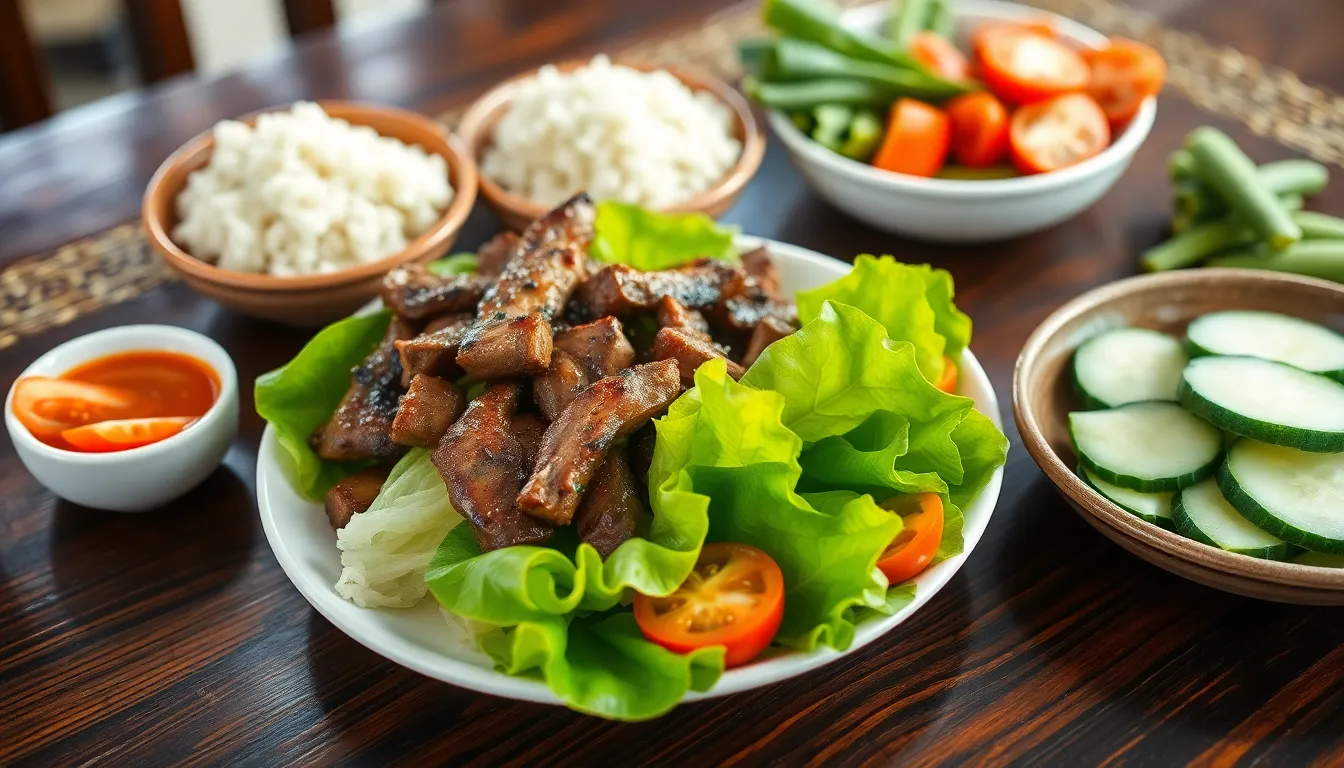
We arrange the beautifully seared beef over a bed of fresh lettuce leaves on individual serving plates. The traditional presentation showcases the caramelized beef as the centerpiece while surrounding it with crisp vegetables that provide textural contrast.
We place steamed jasmine rice alongside the beef and vegetables to create the authentic Cambodian dining experience. The fragrant rice serves as both a base and complement to the bold flavors of the marinated meat. We recommend serving the rice warm to enhance its aromatic qualities.
We present the tangy lime-pepper dipping sauce in small individual bowls beside each plate. This distinctive sauce combines fresh lime juice with ground black pepper and fish sauce to create the signature bright and zesty flavor profile that defines Beef Lok Lak.
Traditional Eating Method:
We encourage diners to create lettuce wraps by placing a piece of beef onto a fresh lettuce leaf. We add a spoonful of jasmine rice along with sliced tomatoes and cucumbers to build layers of flavor and texture. We then drizzle the lime-pepper dipping sauce over the wrap before enjoying each bite.
Presentation Tips:
| Component | Arrangement | Temperature |
|---|---|---|
| Beef | Center of plate over lettuce | Hot |
| Fresh vegetables | Surrounding the beef | Room temperature |
| Jasmine rice | Separate portion on plate | Warm |
| Dipping sauce | Individual small bowls | Room temperature |
We serve this dish immediately while the beef remains hot and tender. The combination of warm beef with cool fresh vegetables creates a delightful temperature contrast that enhances the overall dining experience. We find that guests particularly enjoy the interactive nature of creating their own lettuce wraps with the provided components.
We garnish each plate with additional lime wedges for those who prefer extra citrus brightness. The visual appeal of the colorful vegetables against the rich brown beef creates an inviting presentation that honors the dish’s Cambodian heritage.
Tips for the Perfect Beef Lok Lak

Choose the Right Cut of Beef
We recommend selecting well-marbled cuts like ribeye or New York strip for optimal flavor and tenderness. Sirloin and tenderloin also work beautifully for this dish. Trim any large fat pockets from your chosen cut to prevent excessive grease during cooking. The marbling should be present but not overwhelming to maintain the perfect balance.
Master the Marinating Process
Our marinating technique requires at least 20 minutes for basic flavor penetration. Allow the beef to marinate longer for deeper taste development without overpowering the natural beef flavor. We suggest using dark soy sauce specifically for both color enhancement and added sweetness. Balance is key when combining soy sauce, oyster sauce, tomato sauce, and fish sauce in your marinade.
Use Proper Tenderizing Methods
For tougher cuts, we apply a brief tenderizing treatment using baking soda and water. Avoid over-soaking to preserve the authentic beef taste and texture. Pat the meat completely dry after tenderizing to ensure proper searing during cooking. This technique keeps the beef juicy while maintaining its natural flavor profile.
Perfect Your Cooking Technique
High heat cooking is essential for achieving the signature “shaking beef” effect. We use oils with high smoke points to prevent burning while creating that glossy pepper sauce coating. Keep the beef moving constantly in the pan for even searing on all surfaces. Cook quickly to maintain medium-rare or medium doneness for optimal tenderness.
Incorporate Authentic Seasonings
Fresh Kampot green peppercorns elevate the dish with authentic fragrance and heat when available. We recommend using palm sugar over regular sugar for traditional sweetness. Freshly ground black pepper provides better flavor than pre-ground alternatives. Garlic and shallots should be fresh for the most aromatic results.
Balance Flavors with Fresh Components
Crisp lettuce, ripe tomatoes, and fresh cucumbers provide essential textural contrast to the rich beef. We prepare the lime, black pepper, and salt dipping sauce separately to maintain its bright acidity. The tangy sauce cuts through the savory umami flavors of the meat perfectly. Fresh vegetables should be served at room temperature for the best eating experience.
Make-Ahead Instructions

Planning ahead transforms this delicious Cambodian dish into a stress-free meal that delivers authentic flavors without last-minute preparation chaos. We recommend preparing several components in advance to ensure smooth cooking and serving.
Marinating the Beef in Advance
The beef benefits tremendously from extended marination time. Cut your beef into 3-5 mm slices or small cubes and place them in the marinade mixture up to 24 hours before cooking. Store the marinated beef in an airtight container in the refrigerator during this time. Extended marination allows the Kampot pepper, oyster sauce, soy sauce, fish sauce, garlic, and palm sugar to penetrate deeply into the meat fibers.
Preparing Fresh Vegetables
Fresh vegetables maintain their crispness when prepped ahead properly. Wash and slice the romaine lettuce, tomatoes, cucumbers, and carrots the night before serving. Store each vegetable type in separate airtight containers in the refrigerator to prevent cross-contamination and maintain optimal freshness. The onions used in the stir-fry can also be sliced and stored separately.
Storage Timeline Guidelines
| Component | Maximum Storage Time | Storage Method |
|---|---|---|
| Marinated beef | 24 hours | Refrigerator, airtight container |
| Sliced vegetables | Overnight | Refrigerator, separate containers |
| Cooked beef lok lak | 2 days | Refrigerator only |
| Lime pepper dipping sauce | 3 days | Refrigerator, covered |
Quick Assembly Strategy
When ready to serve, the actual cooking process takes only minutes thanks to your advance preparation. Heat your wok or skillet over high heat and sear the pre-marinated beef for 30 seconds to 1 minute per side. Add the pre-sliced onions partway through cooking and continue with the sauce assembly process. This approach ensures the vegetables remain crisp while the beef achieves the perfect sear.
We strongly advise against freezing the assembled dish once vegetables are added, as this compromises the texture that makes beef lok lak so appealing. The contrast between the hot, savory beef and cool, crisp vegetables creates the authentic dining experience that defines this beloved Cambodian dish.
Storage and Reheating
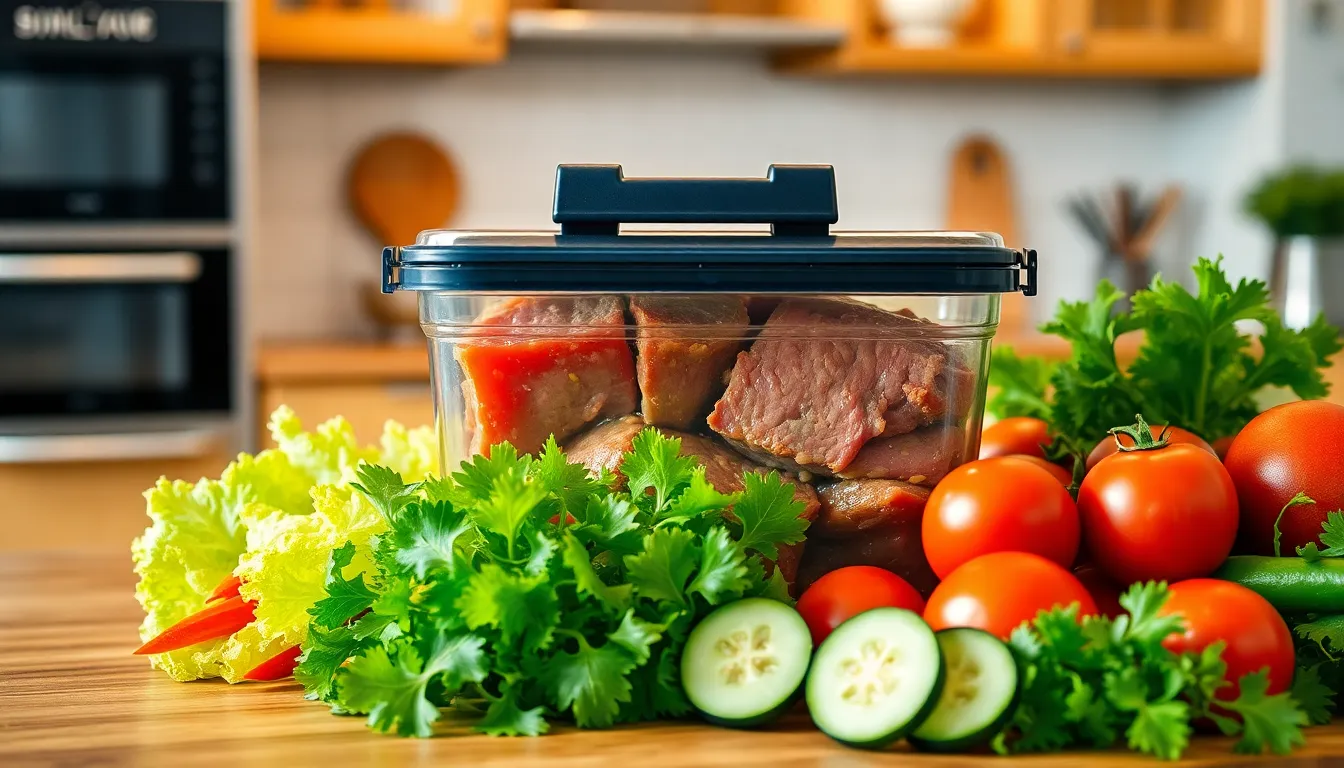
Proper storage techniques ensure our Beef Lok Lak maintains its authentic flavors and textures for future enjoyment. We recommend storing leftover beef in an airtight container in the refrigerator where it stays fresh for 2-3 days maximum. The marinated beef should be kept separate from fresh vegetables to prevent the lettuce and cucumber from becoming soggy.
Our dipping sauce stores beautifully in the refrigerator for up to one week when kept in a sealed container. Fresh vegetables like lettuce, tomatoes, and onions maintain their crispness when stored separately in the crisper drawer. We always wrap cut vegetables in paper towels before placing them in storage containers to absorb excess moisture.
| Storage Component | Method | Duration |
|---|---|---|
| Cooked Beef | Airtight container, refrigerated | 2-3 days |
| Dipping Sauce | Sealed container, refrigerated | Up to 1 week |
| Fresh Vegetables | Crisper drawer, wrapped in paper towels | 3-5 days |
Reheating requires gentle techniques to preserve the beef’s tender texture and prevent overcooking. We reheat the beef in a skillet over medium heat, adding a splash of water or small amount of oil to prevent drying. Stirring constantly ensures even heating without toughening the meat.
Microwave reheating works well for quick meals, though we cover the container with a damp paper towel to maintain moisture. Heat in 30-second intervals, stirring between each session until warmed through completely. The beef should reach an internal temperature that feels hot to touch but not scalding.
We never recommend reheating the fresh vegetables, as they lose their essential crispness that provides textural contrast to the warm beef. Instead, we prepare new lettuce leaves, cucumber slices, and tomato pieces for the best dining experience. The dipping sauce tastes best at room temperature, so we remove it from the refrigerator 15 minutes before serving our reheated Beef Lok Lak.
Conclusion
We’ve walked you through every step of creating authentic Cambodian Beef Lok Lak that’ll transport your taste buds straight to Phnom Penh. From selecting the perfect cut of beef to mastering the signature “shaking” technique this recipe delivers restaurant-quality results in your own kitchen.
The beauty of Beef Lok Lak lies in its simplicity and the harmony between tender marinated beef crisp fresh vegetables and that irresistible tangy dipping sauce. With our make-ahead tips and storage guidance you can enjoy this Southeast Asian favorite whenever the craving strikes.
Now it’s time to fire up that wok and experience the magic of Cambodia’s most beloved beef dish. Your family and friends will be amazed by the complex flavors you’ve created with such straightforward techniques.
Frequently Asked Questions
What is Beef Lok Lak?
Beef Lok Lak is a beloved Cambodian dish featuring tender marinated beef with a perfect blend of sweet and savory flavors. This iconic Southeast Asian dish showcases the fusion of Cambodian and French colonial influences, making it a staple in Cambodian cuisine. The name comes from the “shaking” or tossing motion used during cooking.
What cut of beef works best for Lok Lak?
The best cuts for Beef Lok Lak are well-marbled options like ribeye, New York strip, sirloin, or tenderloin. These cuts provide optimal flavor and tenderness. For tougher cuts like flat iron, proper tenderizing techniques can be used to achieve the desired texture and ensure the beef remains tender.
How long should I marinate the beef?
Marinate the beef for at least 20 minutes for basic flavor absorption. For deeper flavor penetration and enhanced taste, marinate up to 24 hours in the refrigerator. The marinade typically includes soy sauce, oyster sauce, fish sauce, and garlic, which creates the dish’s signature Cambodian flavors.
What is the traditional dipping sauce for Lok Lak?
The traditional dipping sauce is a tangy lime-pepper sauce that complements the rich beef flavors. It maintains bright acidity and includes lime juice and pepper as key components. This sauce is essential for authentic Cambodian dining and should be served at room temperature for optimal flavor.
How should Beef Lok Lak be served?
Serve Beef Lok Lak over fresh lettuce leaves with steamed jasmine rice and the dipping sauce in small bowls. Include fresh vegetables like tomatoes and onions for presentation. Diners traditionally create lettuce wraps with the beef, rice, and vegetables for an interactive dining experience.
Can I make Beef Lok Lak ahead of time?
Yes, you can marinate the beef up to 24 hours in advance and prepare fresh vegetables the night before. However, the actual cooking should be done just before serving to maintain the dish’s signature contrast between hot beef and cool vegetables. The dipping sauce can be made up to a week ahead.
How do I store leftover Beef Lok Lak?
Store leftover beef in an airtight container in the refrigerator for 2-3 days. Keep the dipping sauce sealed for up to a week. Store fresh vegetables separately to prevent sogginess. Avoid freezing the assembled dish as it compromises the essential textural contrast that defines authentic Lok Lak.
What cooking technique is essential for authentic Lok Lak?
High heat cooking with constant movement is essential for authentic Beef Lok Lak. Use a wok or large skillet and employ the signature “shaking” motion to achieve even searing while maintaining tenderness. This technique creates the caramelized exterior while preventing overcooking, preserving the dish’s authentic texture and flavor.

